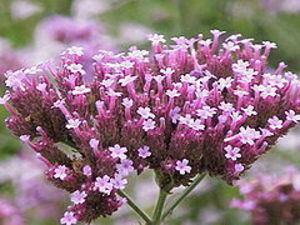Verbenas are grown as annuals in zones below 7. In zones 7 through 10, they are grown as a hardy perennial in the U.S. The plants grow to heights of 8 to 12 inches, with a spread of 2 to 4 feet. The flowers are fragrant, appearing in the spring and they continue through to the fall. The flowers come in a variety of colors like, violet, lavender, pink, red and white. Verbena is an old-fashioned plant that gardeners often grow in flower beds, window boxes or containers.
Choose the Right Soil
Verbena seeds need to grow in a fine type of soil. Seed starter soil works great, but if you want to use your own multipurpose compost, run it through a sieve to remove lumps or hard pieces. Place the items that won’t fit through the sieve into your compost pile where it can break down further.
Fill Cell Packs
Place cell pack inserts into a seeding tray. Fill the cell packs with the starter soil or sieved compost to 1/ 4 inch below the rim. Fill as many full-sized cells as you have seeds to plant. Cell seeding packs are sold at garden supply store, garden catalogues or online.
Settle the Soil
Pick up the tray and bang it on the counter several times. This settles the soil and the soil level will fall to about a half inch below the rim. Tamp the soil down in each cell with a tamper. A tamper is a special tool that fits into the pack and firms the soil in place. If you don’t have one, you can use your fingers, or make a tamper by cutting a piece of wood so it fits into the top of the cell pack. Cut another piece of wood and nail it on top to make a handle. It does not have to be perfect. Do not press the soil so hard that it compacts. You just want the top to be smooth so the seeds don’t fall too deep in the soil.
Place one seed per cell. Barely cover the seeds with starter soil or sieved compost. The depth of the seeds should equal their length. If seeds are planted too deep, they will not grow.
Fill a sprayer bottle and lightly mist the top of the soil to settle it over the seeds. Once you have the top soil moistened, fill a container with tepid water. Set the cell packs into the container and allow them to soak until the soil is damp. You only want to moisten the soil, not drench it. When your soil is too wet, the seeds could rot.
Cover the cell packs with a piece of plastic and place it on a heat mat set to 60 to 68 degrees Fahrenheit. If you don’t have a heat mat, many gardeners place the seed trays on top of the refrigerator. Check the soil daily for moisture. If the soil feels dry, mist it with a sprayer. The verbena takes 15 to 20 days to germinate.
Remove Plastic Covering
When the seeds have germinated, remove the plastic cover. Move the tray to a brighter area, but keep the see3dingsk out of direct sunlight. The temperature should remain around 60 to 70 degrees Fahrenheit.
Transplanting the Verbena
When the verbenas have their second set of true leaves, it is time to transplant them into 3-inch pots or outdoors into prepared containers or beds. Fill the pots with well-drained potting soil, leaving the soil 1/ 4 to ½ inch below the pot’s rim.
Insert a dibble or a pencil into the soil to form a hole. Remove the verbena plant and place the roots into the formed hole. Always grasp the seedlings by their leaves, never the stem or you risk injuring them. Fill in the hole with the soil. Keep the planting depth the same as they were growing originally or the stems may rot.
Set the pots in a container of water and allow to soak until the soil is moist. Continue to grow the verbena in a bright area. When your area has no danger of frost, transplant the verbena into your garden, or container outdoors.
Source:
“American Horticultural Society A to Z Encyclopedia of Garden Plants”; Christopher Brickell; 2004


